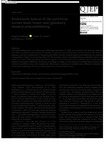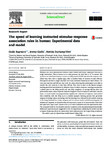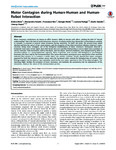Decoding Music-Evoked Emotions in the Auditory and Motor Cortex
| dc.contributor.author | Putkinen, Vesa | |
| dc.contributor.author | Nazari-Farsani, S | |
| dc.contributor.author | Seppälä, K | |
| dc.contributor.author | Karjalainen, Tomi | |
| dc.contributor.author | Sun, L | |
| dc.contributor.author | Karlsson, HK | |
| dc.contributor.author | Hudson, Matthew | |
| dc.contributor.author | Heikkilä, TT | |
| dc.contributor.author | Hirvonen, J | |
| dc.contributor.author | Nummenmaa, L | |
| dc.date.accessioned | 2021-08-20T16:41:53Z | |
| dc.date.issued | 2021-03-31 | |
| dc.identifier.issn | 1047-3211 | |
| dc.identifier.issn | 1460-2199 | |
| dc.identifier.uri | http://hdl.handle.net/10026.1/17627 | |
| dc.description.abstract |
<jats:title>Abstract</jats:title> <jats:p>Music can induce strong subjective experience of emotions, but it is debated whether these responses engage the same neural circuits as emotions elicited by biologically significant events. We examined the functional neural basis of music-induced emotions in a large sample (n = 102) of subjects who listened to emotionally engaging (happy, sad, fearful, and tender) pieces of instrumental music while their hemodynamic brain activity was measured with functional magnetic resonance imaging (fMRI). Ratings of the four categorical emotions and liking were used to predict hemodynamic responses in general linear model (GLM) analysis of the fMRI data. Multivariate pattern analysis (MVPA) was used to reveal discrete neural signatures of the four categories of music-induced emotions. To map neural circuits governing non-musical emotions, the subjects were scanned while viewing short emotionally evocative film clips. The GLM revealed that most emotions were associated with activity in the auditory, somatosensory, and motor cortices, cingulate gyrus, insula, and precuneus. Fear and liking also engaged the amygdala. In contrast, the film clips strongly activated limbic and cortical regions implicated in emotional processing. MVPA revealed that activity in the auditory cortex and primary motor cortices reliably discriminated the emotion categories. Our results indicate that different music-induced basic emotions have distinct representations in regions supporting auditory processing, motor control, and interoception but do not strongly rely on limbic and medial prefrontal regions critical for emotions with survival value.</jats:p> | |
| dc.format.extent | 2549-2560 | |
| dc.format.medium | ||
| dc.language | en | |
| dc.language.iso | eng | |
| dc.publisher | Oxford University Press (OUP) | |
| dc.subject | MVPA | |
| dc.subject | emotion | |
| dc.subject | fMRI | |
| dc.subject | music | |
| dc.subject | pattern classification | |
| dc.subject | Adult | |
| dc.subject | Amygdala | |
| dc.subject | Auditory Cortex | |
| dc.subject | Brain | |
| dc.subject | Emotions | |
| dc.subject | Female | |
| dc.subject | Functional Neuroimaging | |
| dc.subject | Gyrus Cinguli | |
| dc.subject | Humans | |
| dc.subject | Insular Cortex | |
| dc.subject | Magnetic Resonance Imaging | |
| dc.subject | Male | |
| dc.subject | Middle Aged | |
| dc.subject | Motor Cortex | |
| dc.subject | Music | |
| dc.subject | Parietal Lobe | |
| dc.subject | Somatosensory Cortex | |
| dc.subject | Young Adult | |
| dc.title | Decoding Music-Evoked Emotions in the Auditory and Motor Cortex | |
| dc.type | journal-article | |
| dc.type | Journal Article | |
| dc.type | Research Support, Non-U.S. Gov't | |
| plymouth.author-url | https://www.ncbi.nlm.nih.gov/pubmed/33367590 | |
| plymouth.issue | 5 | |
| plymouth.volume | 31 | |
| plymouth.publication-status | Published | |
| plymouth.journal | Cerebral Cortex | |
| dc.identifier.doi | 10.1093/cercor/bhaa373 | |
| plymouth.organisational-group | /Plymouth | |
| plymouth.organisational-group | /Plymouth/Faculty of Health | |
| plymouth.organisational-group | /Plymouth/Faculty of Health/School of Psychology | |
| plymouth.organisational-group | /Plymouth/REF 2021 Researchers by UoA | |
| plymouth.organisational-group | /Plymouth/REF 2021 Researchers by UoA/UoA04 Psychology, Psychiatry and Neuroscience | |
| plymouth.organisational-group | /Plymouth/Users by role | |
| plymouth.organisational-group | /Plymouth/Users by role/Academics | |
| dc.publisher.place | United States | |
| dcterms.dateAccepted | 2020-11-06 | |
| dc.rights.embargodate | 9999-12-31 | |
| dc.identifier.eissn | 1460-2199 | |
| dc.rights.embargoperiod | Not known | |
| rioxxterms.versionofrecord | 10.1093/cercor/bhaa373 | |
| rioxxterms.licenseref.uri | http://www.rioxx.net/licenses/all-rights-reserved | |
| rioxxterms.licenseref.startdate | 2021-03-31 | |
| rioxxterms.type | Journal Article/Review |




